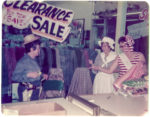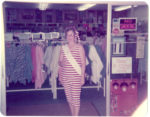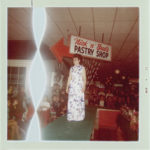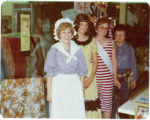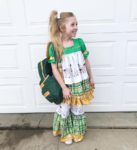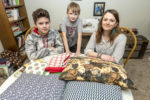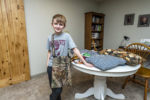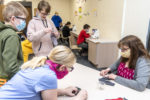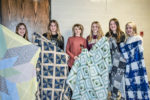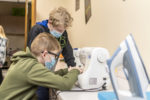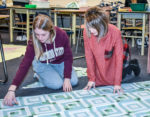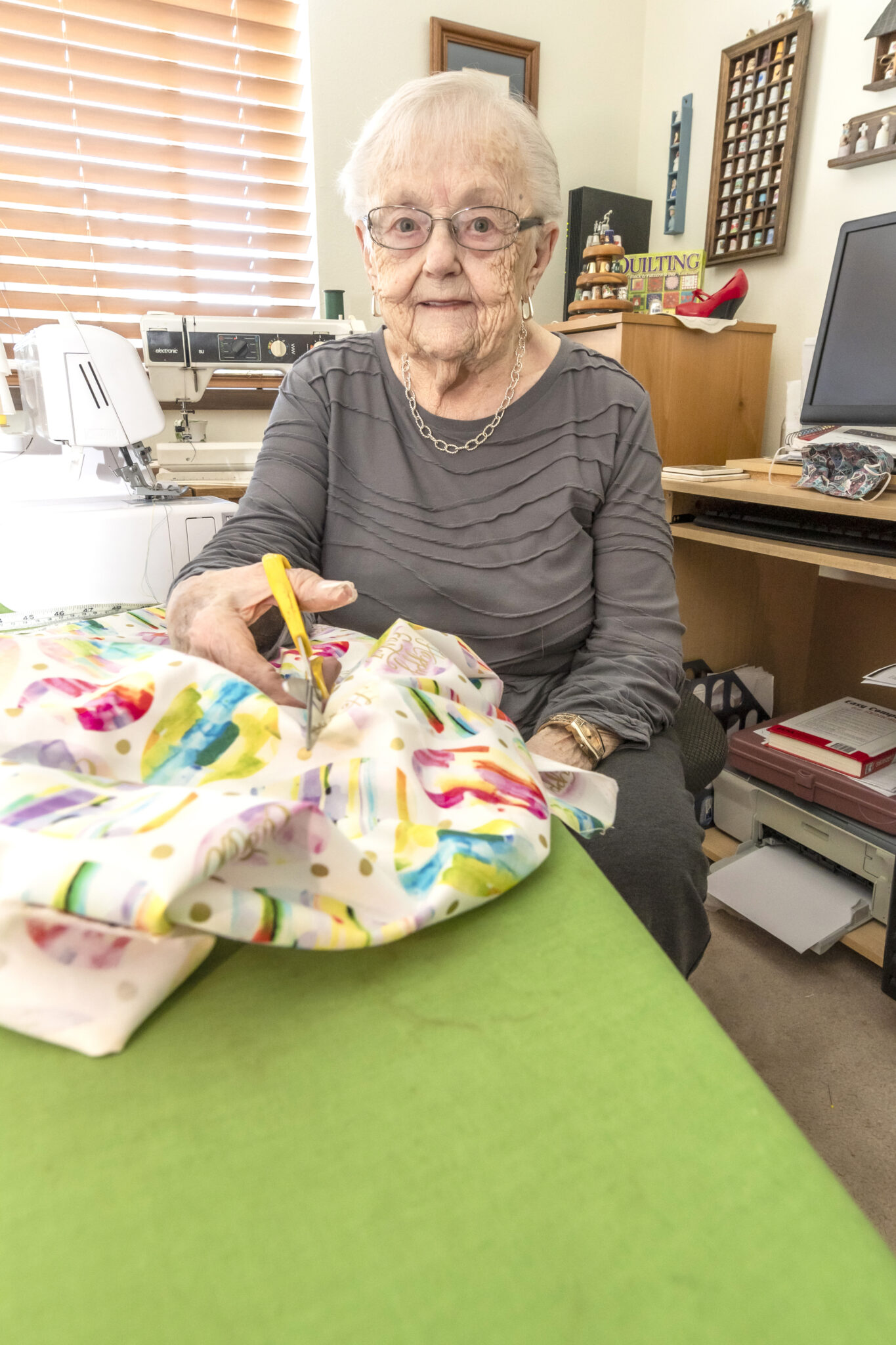

Being able to take a piece of fabric, cut it into pieces, and fashion that into a beautiful piece of clothing is an art.
I didn’t realize how amazing that process was as I grew up learning to sew. My mom was an Extension agent who taught sewing, my sister sewed, and most of my friends sewed. It was what you did, much like playing games on your phone today.
Growing up in the 1960s and 1970s, purchasing ready-made clothes was seldom an option for our family. Walking into a fabric store offered endless possibilities. Pattern books conjured up ideas on how to turn the beautiful fabric into the latest style. A piece of pale blue corduroy would make a striking skirt. The wheat-flecked wool could be a stylish maxi vest.
My first project was an apron, a basic rectangle with a drawstring and machine hem. Ten years in 4-H took me through yards of fabric as I sewed for myself, my mom, and my younger sister. Yet, I haven’t sewed a garment in years. My sewing machine sits idle in an upstairs bedroom, used only for a quilting project or to fix a hem.
Once a necessity in every household, those who sew are now rare. I talked to a few who shared their passion for this craft.
Stitching Time
Sewing has been a lifelong passion for an Aberdeen woman who enjoys creating every day. When visiting a friend this winter, I met Sally Kushman, 94. We started chatting, and I knew she looked familiar. She was the extremely helpful lady who sold me fabric. Sally managed The World of Fabric store in the Super City Mall.
Sally’s commitment to sewing didn’t begin until she was 21. “Mother was a seamstress and a perfectionist. She would remake clothes for us kids. If mother’s dress had a stain or a tear, she would remake it into a dress or an apron for us kids. Seldom were clothes made just for us. I started sewing after I got married when we moved to Aberdeen in 1945.”
Learning to sew meant she had to master a treadle sewing machine. “Once I got the rhythm down, controlling the speed and regulating the stitches was easy.” (The power to drive the treadle machine comes from feet rocking back and forth on a foot pedal rather than from electricity.)
She recalled her first outfit as a challenge. “I don’t know why, but I bought the biggest red plaid I could find to make a two-piece suit. Anyone who has worked with plaids knows that takes a lot of work. By sheer determination, I got it done.”
At a store called Fran’s, Sally made model garments for Fran Coester. She fashioned dresses, baptismal dresses, and anything Fran asked her to make for display. Sally even made wedding dresses. She vividly recalled finishing the hand sewing on one wedding dress at Girl Scout camp at Richmond Lake.
Such projects didn’t daunt Sally. “For our oldest granddaughter’s wedding dress, I stopped counting after I’d sewn on 4,750 pearls by hand. And I finished that in a camper when we traveled to Florida.” I call that dedication.
Through the years, she sewed everything for her daughters and others who asked. “I made my husband a suit coat. The hardest part was making sure the lapels and collar matched. I even made a leather jacket.”
The Super City Mall opened in 1965 with Mrs. Blow’s Fabric & Sewing Center offering just about everything for people who wanted to sew. Sally loved the store, and Mrs. Blow asked her to work for her.
Two years later, the store was renamed The World of Fabric. Sally’s helpful manner soon had her working full time. In 1971, she took over as manager.
When polyester reached the market in the 1950s, it was a wonder fiber. People would wash garments, hang them up, and have them ready to wear in a few hours. With these fabrics available in stores, it meant the ’60s and ’70s were heydays for those wanting clothes with style. Customers could sew clothes for a lot less than those available in department stores. It wasn’t just women who sewed. “I had fellows come in to get fabric for snowmobile suits.”
At World of Fabric, customers marveled at the hundreds of bolts of fabric in a myriad of colors and designs made of polyesters, cottons, wools, fake furs, and Hardanger, a crafting fabric. The store included notions such as ribbons, rickrack, and seam binding plus buttons. “At one time, we had $2,000 worth of buttons in the store,” Sally said. “People would look through pattern books to find the latest styles for their new outfits. At one time, patterns sold for 95 cents or $1.95. That price was about the same as a loaf of bread. I can’t believe patterns now sell for $20.”
Sally became a trusted source for information about sewing. Her experience helped customers figure out problems they had with sewing, or she’d share the latest technique with them. She remembered, “Lots of 4-Hers came through the doors, and I still see some of them.”
After 21 years, Sally retired. People changed, fabric changed, shopping changed. Increased options in stores for low-cost clothing meant it might be cheaper to purchase a ready-made dress rather than sew one. People bought a lot less fabric. World of Fabric closed in 1992.
After traveling for 10 years, Sally settled down in Aberdeen, where she continues to be active. Two machines stand ready in her sewing room to tackle any project. Besides her regular machine, she’s found a serger makes quick work for edges, rolled hems, and blind stitching.
Her sharp brown eyes have no trouble with hand sewing. With her thimble, she can expertly tackle most any work. While she no longer sews clothes for herself, she works with the Exchange Club to reinforce the hems on United States flags so they can handle South Dakota winds. The ladies of her church cut out quilt squares and rely on her to sew the blocks together. And, like many who sew, she made many masks this last year.
She still has a stash of fabric that she’ll use for projects such as table runners. Sometimes she will peruse the fabric in stores just to see what’s available.
As for her favorite fabric, Sally said, “I really like the cotton-polyester for sewing. I detest chiffon. We used to sell a lot of wool. In fact, I have three yards of beautiful Pendleton wool that I’ve never made into anything.”
Now, many people enjoy a different type of sewing as quilting makes a comeback and crafting gains in popularity. Making your own clothes has become a disappearing art. For Sally, this skill brought her great joy through the years, along with memories of great people she’s met along the way.
These 1970s-era pictures were provided by Sally Kushman, who managed World of Fabric in the Super City Mall and include style shows and Crazy Days events.
Kindling A Creative Spirit
Five years ago, Brittany Merkel became enthralled with the world of sewing. “At 30, I started staying home after my second child was six months old. I needed something productive to keep me busy.”
Her grandmother, Leone Dutenhoeffer, came to her rescue. “She got me a yard of purple fabric. We made an apron without using a pattern. I was super fulfilled and excited that I did it.” That ignited her interest in making clothes.
She still treasures the apron and the love she felt making it.
She said her grandmother is an industrious woman who pushed her to pursue crafts that bring Brittany happiness. “Sewing and gardening have allowed me to be creative and inspire our children to appreciate these crafts as well. Grandma is helpful and optimistic and always stays busy.”
Sewing appeals to her need for order. “I was a science teacher, so I love following directions. Sewing is similar, yet different. You cut the fabric; you piece it together into another enormous piece of fabric. There is just something so comforting. You have the time to yourself.”
“I enjoy giving something that people can get nowhere else,” Brittany said. “As a mom of five, I look forward to my creative time. I love staying at home. My job is making sure my kids feel loved and are happy. It gives me joy to carve out time to make things. I can say I made this and I’m proud of it. That’s why I sew.”
Giving birth to her fifth child this spring, baby Pearl joined sister Zoey and three brothers Ezra, Beau and Shiloh.
A blanket with a mermaid tail for her daughter challenged her. “Some of my friends liked them, so I took orders and sold them.” That led to making clothes for Zoey. “I stumbled across a company that sells patterns online.”
Instead of purchasing a pattern in a store, people can select and download the pattern and print it at home. She explained, “Once you print the pages, you tape them together and cut according to the size. They impressed me with the detailed instructions and how easy they were to follow.”
Her contact with that company led her to working for them.
“Last year, I sewed test patterns for this company to make sure the size fit well before it was available for purchase. I learned a lot from the experience, and it made me better at sewing. I remember making the first item for myself and it fit me just right! It was a dress with darts and neat styling.”
She made several outfits and made suggestions to the company. “I made a matching set of dresses for Zoey and me. It was fun with multiple options. The back of the dresses were open, but they could have a zipper. It was fun to coordinate.”
During quarantine, Brittany read the Harry Potter books with Zoey. As a result, she created a dress inspired by Luna Lovegood in the books. Made of black fabric with stars and unicorns, it has buttons down the front. “I’m proud of it. It was my first outfit where my buttonholes were very visible. They turned out well. Now that I conquered those, I’m going to tackle making boys’ shirts, which have lots of tiny buttons.”
When does Brittany find time for sewing when she has five kids? “Truly, it’s late at night,” she said with a laugh.
Brittany said Zoey told her, “‘Mom, I look forward to you making my picture day dress every year.’ This year I didn’t think I could since I was very pregnant and sick quite a bit of the time. I didn’t want to disappoint her. She and I are thrilled with how it turned out. I finished it right in the nick of time. I sewed the buttons on late in the evening just before picture day.”
Brittany said Zoey’s delight in the dress increases her sense of accomplishment, “It has lots of ruffles, and Zoey wears it a lot. She’s a dancer so sometimes she wears the dress without the pettiskirt. Most projects have been for Zoey. It’s always fun planning the pieces together. This year’s outfit is overall my favorite.”
Since she’s been pregnant, she’s taken a break from sewing and is excited to begin future projects. “I plan to sew more for myself as there is nothing like a clothing item that is custom made. I’m looking forward to trying more patterns, including a coat.”
While the price of purchasing fabric and patterns adds up, the time to make gifts for others is something she gives freely. “I want the person to have an heirloom piece. Sometimes it may cost more. You can’t put a price on something that was made just for you.”
Brittany Merkel took up sewing more seriously as a stay-at-home mom. She has worked as a pattern tester, taken custom orders, and sewn outfits for herself and her oldest daughter, Zoey.
Focusing On Useful Projects
Sewing useful craft projects became a creative outlet for the Kiesz family during the last few years. Projects for 4-H were the catalyst for them to learn to sew.
While Wyatt, 13, and Cody, 11, haven’t sewn clothes for themselves, they have learned to make some clever projects with the help of their grandmother, Carole Kiesz. Their mom, Alison, has learned along with them.
Carole lives nearby, and when the boys visited her, they would sometimes sew together scrap fabric on her machine. To encourage them, she bought a sewing machine for the family for 4-H projects and fun items. With limited time in school for Family and Consumer Science class this year, Wyatt made items following online instruction and created some of his own at home.
Wyatt took fabric featuring sports logos and turned it into an apron, which he wore when demonstrating special foods at the Brown County Fair and State Fair level. This last year, Wyatt made prototypes of coffee koozies. One that worked well featured hook and loop fasteners. It took time to figure out what to do to keep the sewing machine needle from getting caught up in the product. He made 14 and sold them to family and friends. He and his brother made several pillows and placemats.
“Grandma helped us if the machine jammed or if we had trouble,” Wyatt said. He looked forward to his fourth-quarter Family and Consumer Science class at Holgate.
A laptop case proved to be a challenge for Cody and his mom. Cody found quilted outdoor fabric that he liked. Turning that heavy material into a finished project took almost six months.
Cody said, “We’d work on it, put it away for a while, and then work on it again. It just had a lot of steps. It also had the hook and loop fasteners. But it was cool when I got done.”
An easier project was a body pillow. They checked the price of fabric and found it was less expensive to purchase a bedsheet than the amount of material needed. Cody explained, “We laid the five pillows out and measured where to sew and pinned it together. It only took a couple of hours to finish. It’s on my bed, and I use it a lot. I entered it into the Brown County Fair for one of my 4-H projects.”
Alison said she didn’t learn to sew and is very thankful for Carole’s help. With the sewing machine in the house, Alison found herself drawn to try some projects. “I made a bag and a simple skirt that I really liked. I watched tutorials to find out how to do things and to help the boys. It is fun to create, but I know my limits. I learned to rip things apart when I make mistakes.”
Knowing those basics is important, she said. “I’m glad the boys have learned to sew. They will know how to patch their jeans or sew on a button. I think they’ve learned lifelong skills while crafting creative projects.”
- Wyatt, Cody, and mom Alison Kiesz have learned to do different sewing projects together for 4-H. The boys’ grandmother, Carole Kiesz, gifted them a sewing machine and has been a huge help in mastering the craft.
- Cody Kiesz shows a laptop case he made using outdoor-themed fabric.
Teaching the Next Generation
In high school in the 1950s to the 1970s, girls spent hours sewing in home economics classes, making skirts and dresses they would wear. (Boys weren’t allowed in those classes and most likely wanted no part of ‘girls’ classes; they took shop courses.) Current curriculum includes boys and girls in the classes called Family and Consumer Science (FACS). Required for Holgate Junior High and Simmons Junior High sixth- and seventh-grade students, the school offers the class as an option for eighth-graders.
Ann Scott, FACS teacher at Aberdeen Holgate, grew up sewing and made many outfits for her daughters. She believes sewing is a fun part of the classes she teaches.
She said, “Some kids grumble, but I think they really enjoy the class and are proud of their projects. I tell them they need to learn the basics, so they don’t have to call their mom when they are living on their own.”
Projects have changed from earlier days, with the focus now on making masks. Rather than sewing something to wear, students make pillowcases, locker caddies, and fleece quilts. Ann focuses on how to use a sewing machine, being able to use a pattern, and other skills they will use. “Sewing on a button is a must!”
Later this year, “One project is hand sewing a ‘germ’ out of felt. We do a food poisoning lesson, and they choose what germ they want to create. All the students seem to like hand sewing. All the students get creative. By linking sewing and food science, the concepts resonate with the kids.”
As a FACS teacher in Groton, Lindsey Tietz says the change in lifestyles has made a tremendous difference in teaching her classes. Students aren’t interested in making clothes to wear. They prefer to make a blanket, potholder, bag, or quilt. With COVID-19 this last year and guidelines set by the school district, students haven’t been able to use the sewing machines as usual. Her FACS IV class, a senior quilting class, is the only class that has been able to sew.
Her students tell her it’s less complicated to find clothes on sale rather than take the time to find the fabric, decide on a pattern, and make the garment. She’s found students are not as comfortable wearing something they’ve made. That’s why she teaches students to sew by making projects such as pajama shorts, aprons, blankets, and potholders.
Lindsey said one of her first assignments in another class is to bring five items that need fixing/mending. Some may bring jeans in need of repair, leggings with holes, or a shirt with missing buttons. They learn how to fix and repair. “That’s a life skill providing knowledge they will use. They learn these skills so they don’t have to pay someone else to take care of it for them.”
With the four-day week at Groton, some senior girls have chosen to quilt at the school on Fridays. Lindsey said, “It’s fun to see their interest in this traditional activity. For some, it becomes addicting. They just want to come to my classroom and sew, sew, sew!” //
- Ann Scott (right), FACS teacher at Aberdeen Holgate, helps her class work on their latest sewing assignment. Photo by Troy McQuillen.
- Lindsey Tietz, Groton FACS teacher (center,) and her students display the final results of their senior quilting class.
- Lindsey and one of her students work on a quilt together. Photos by Kristi Peterson.
- Junior high students at Holgate Middle School have made things like locker caddies, masks, pillowcases, and fleece quilts.












